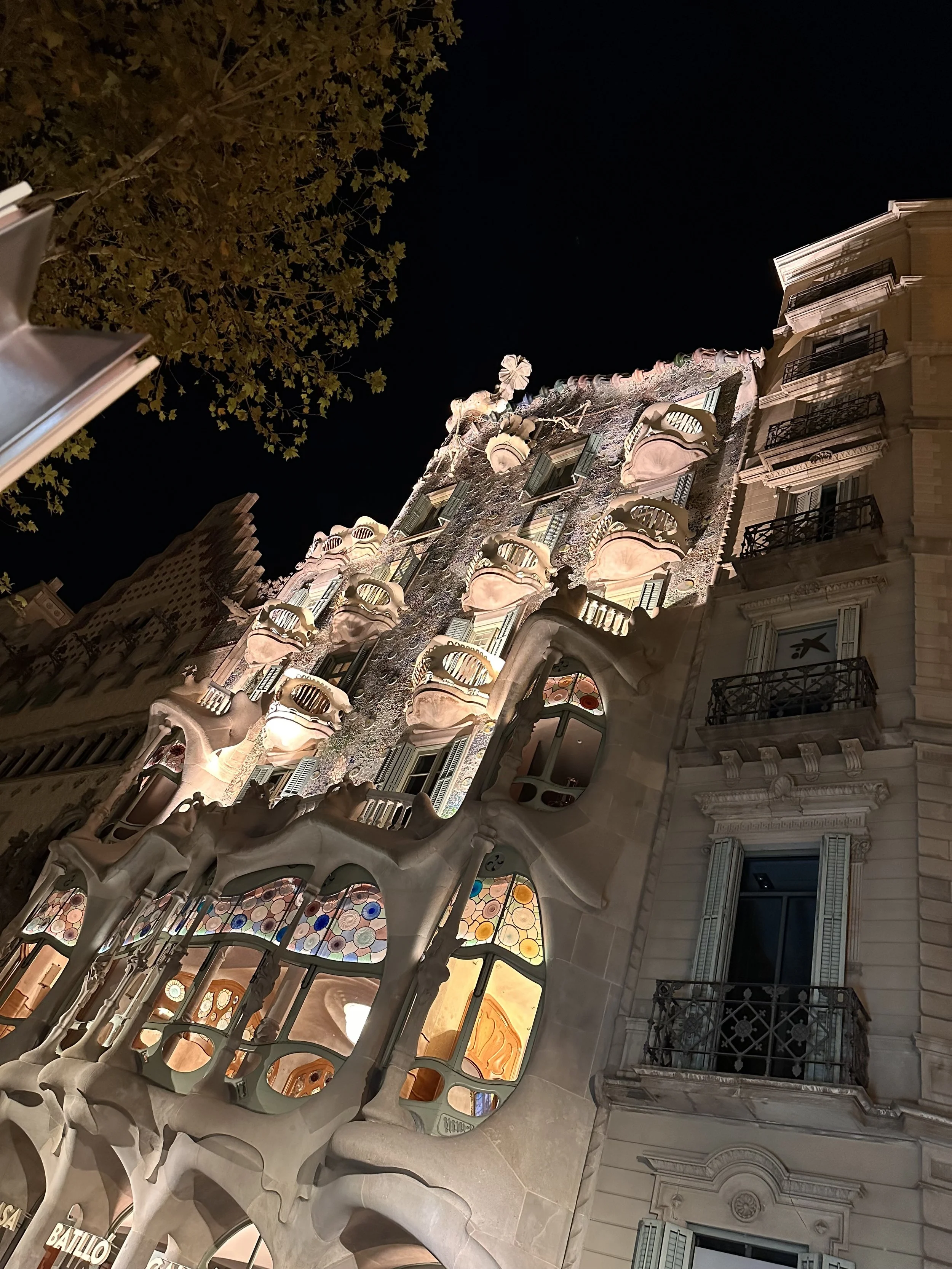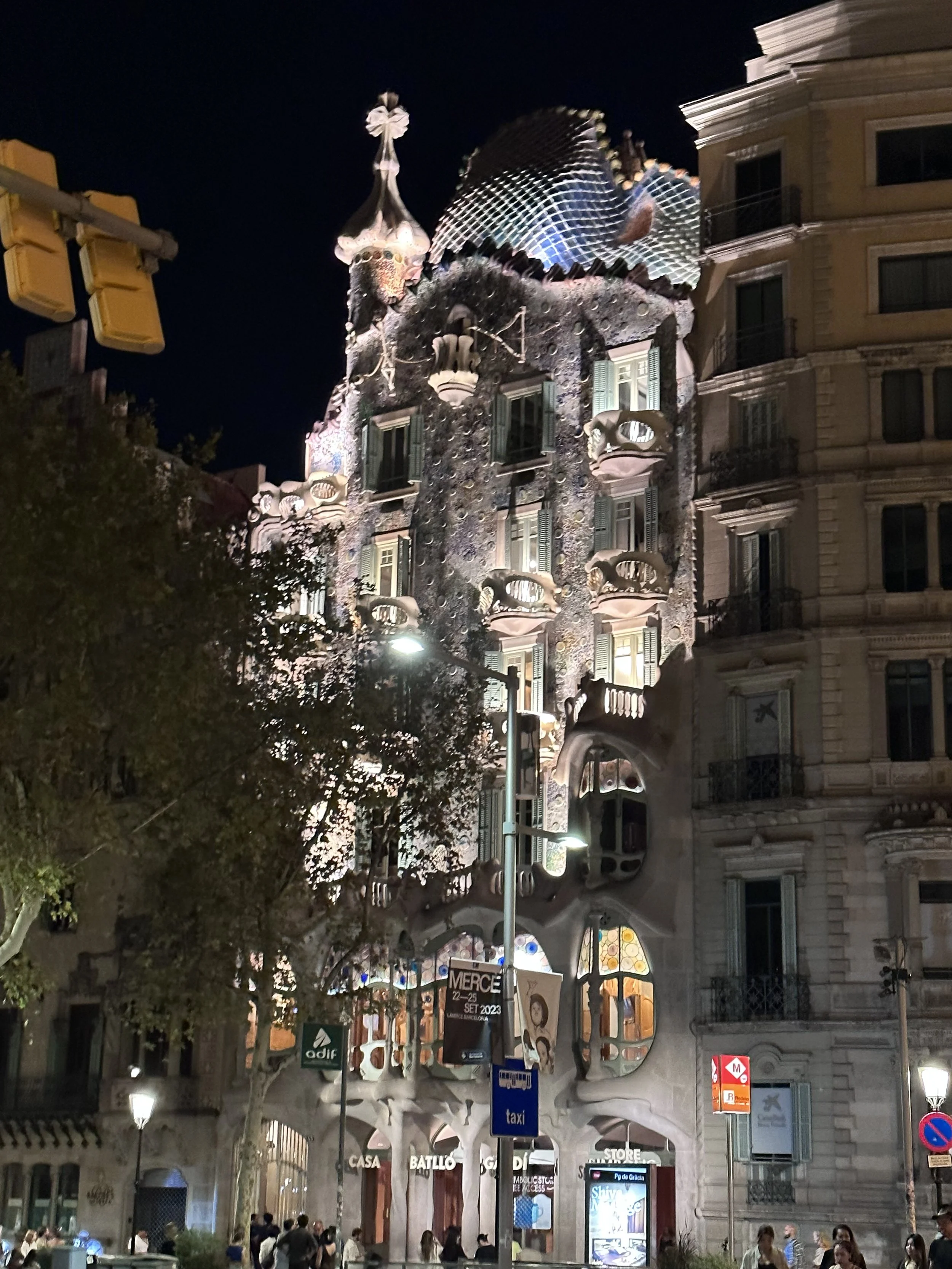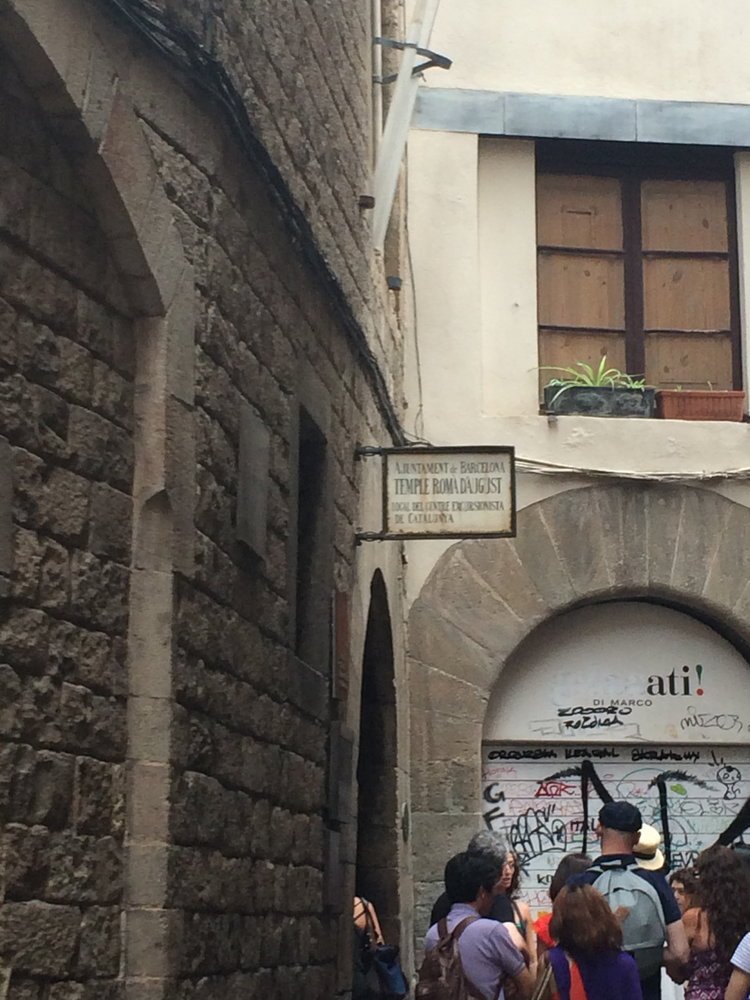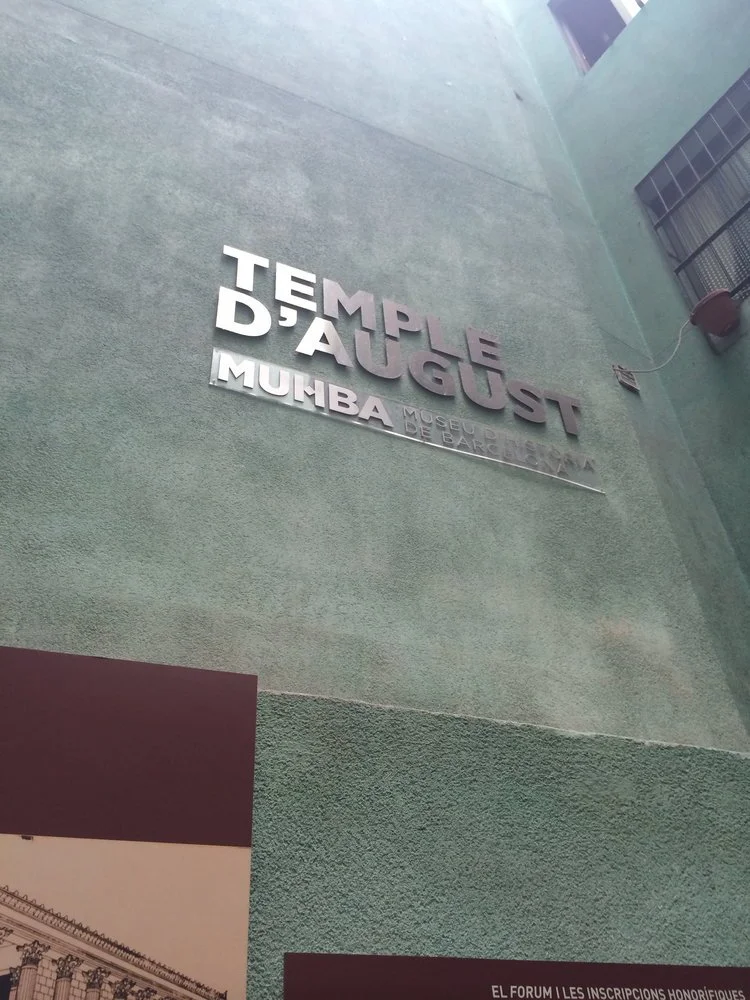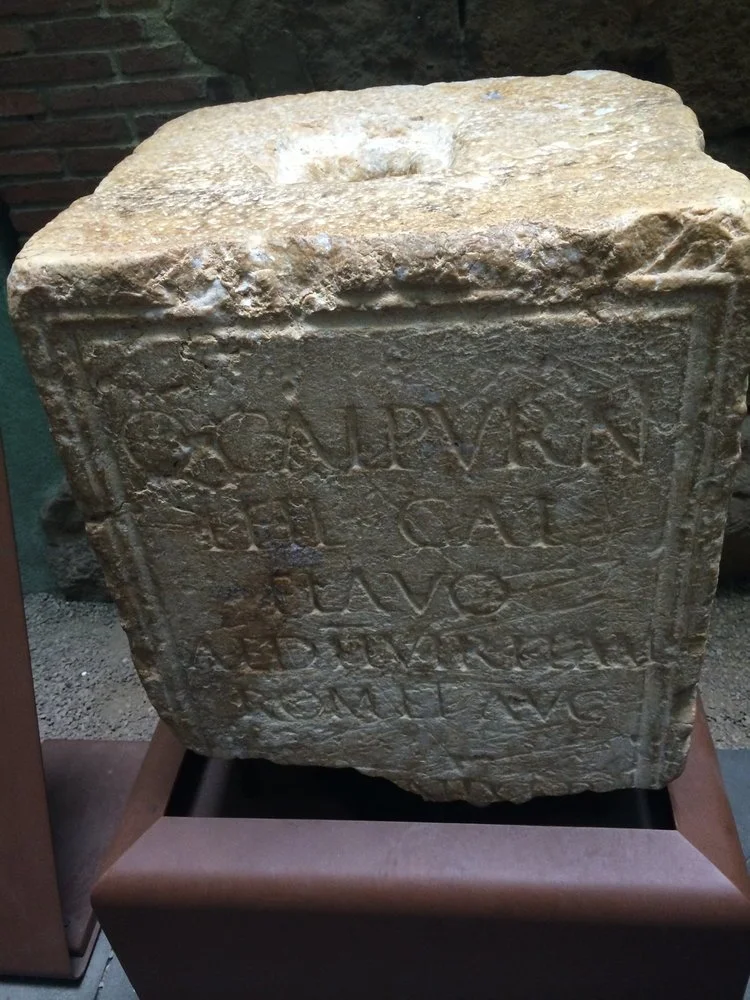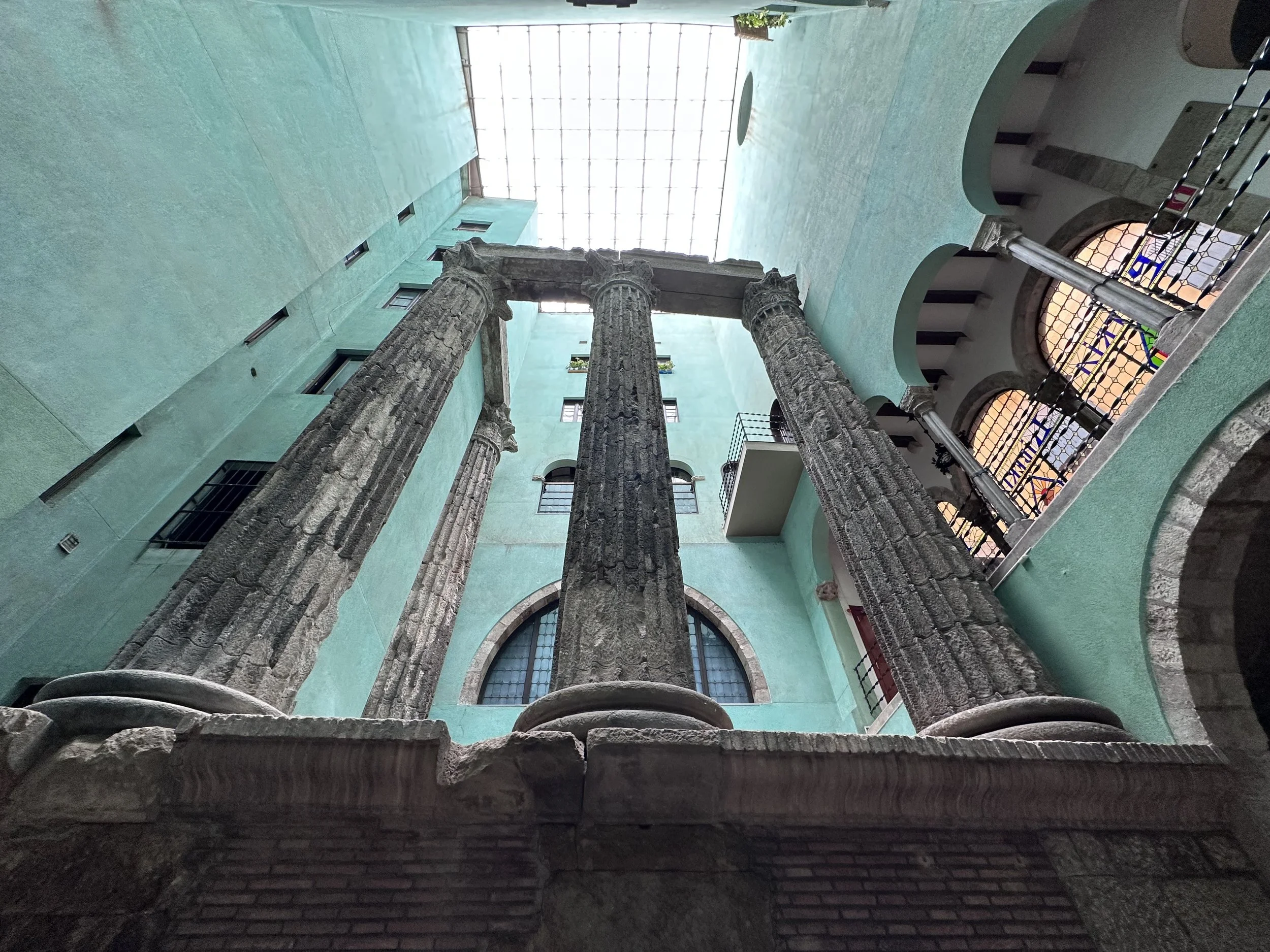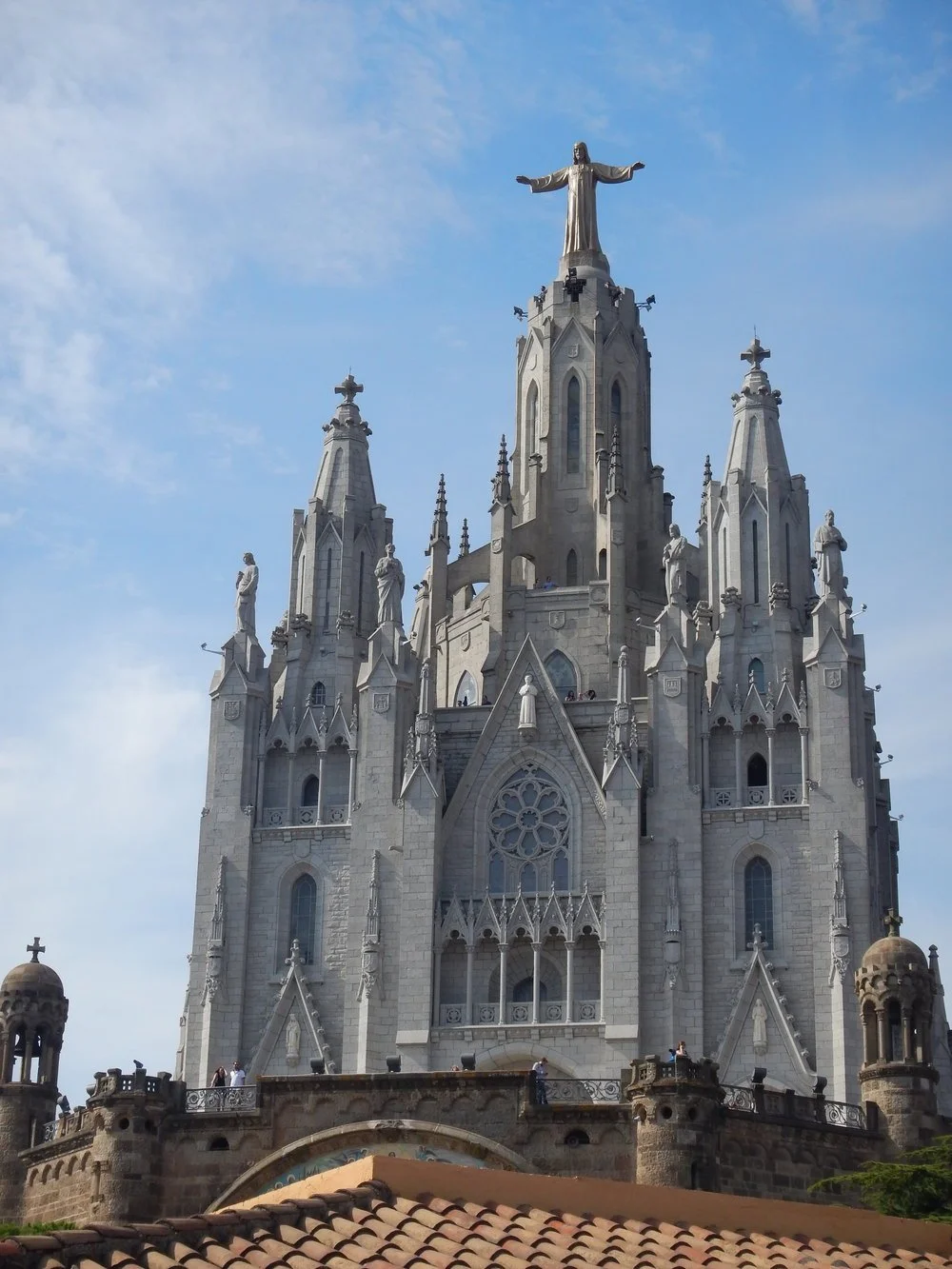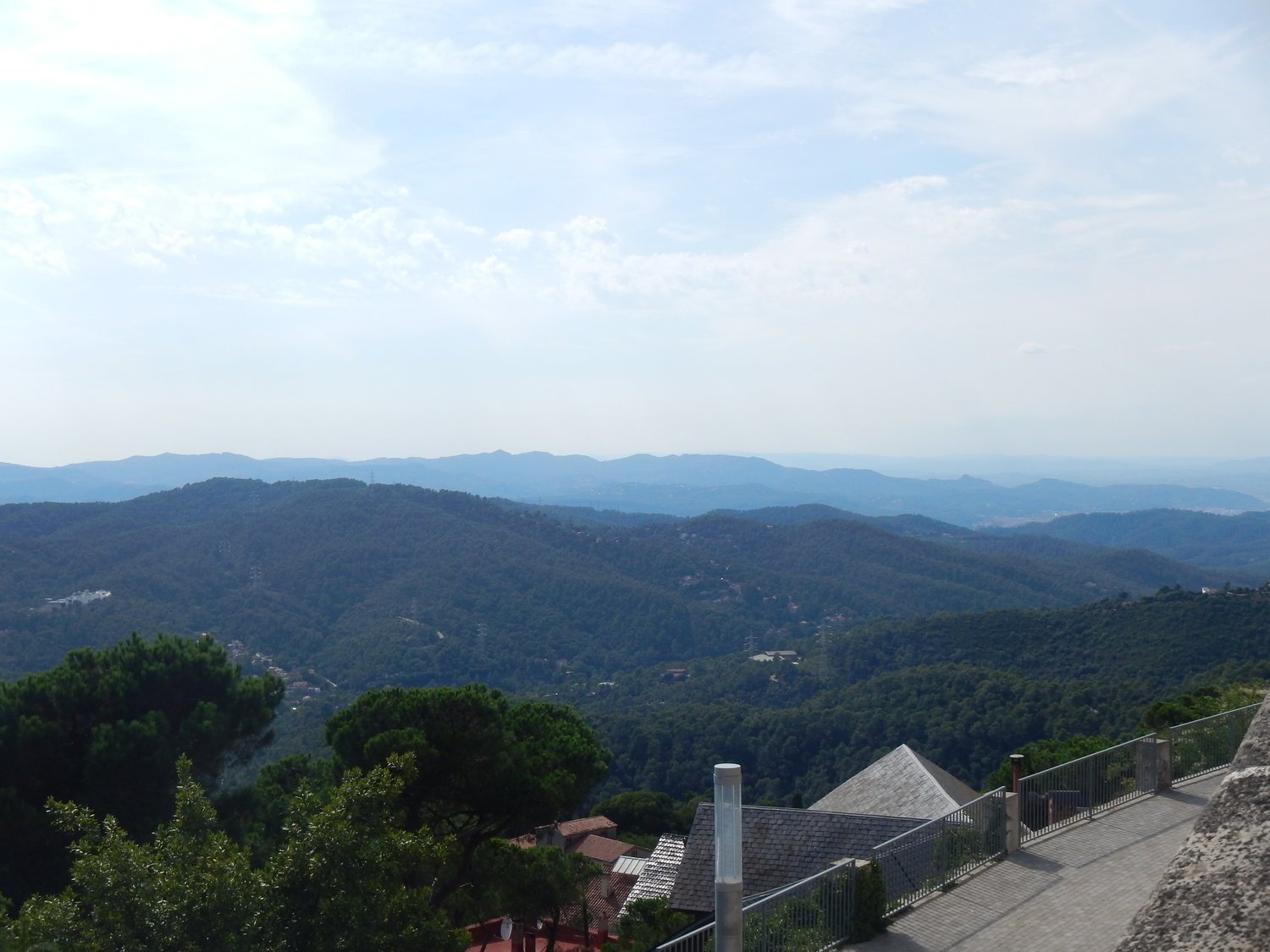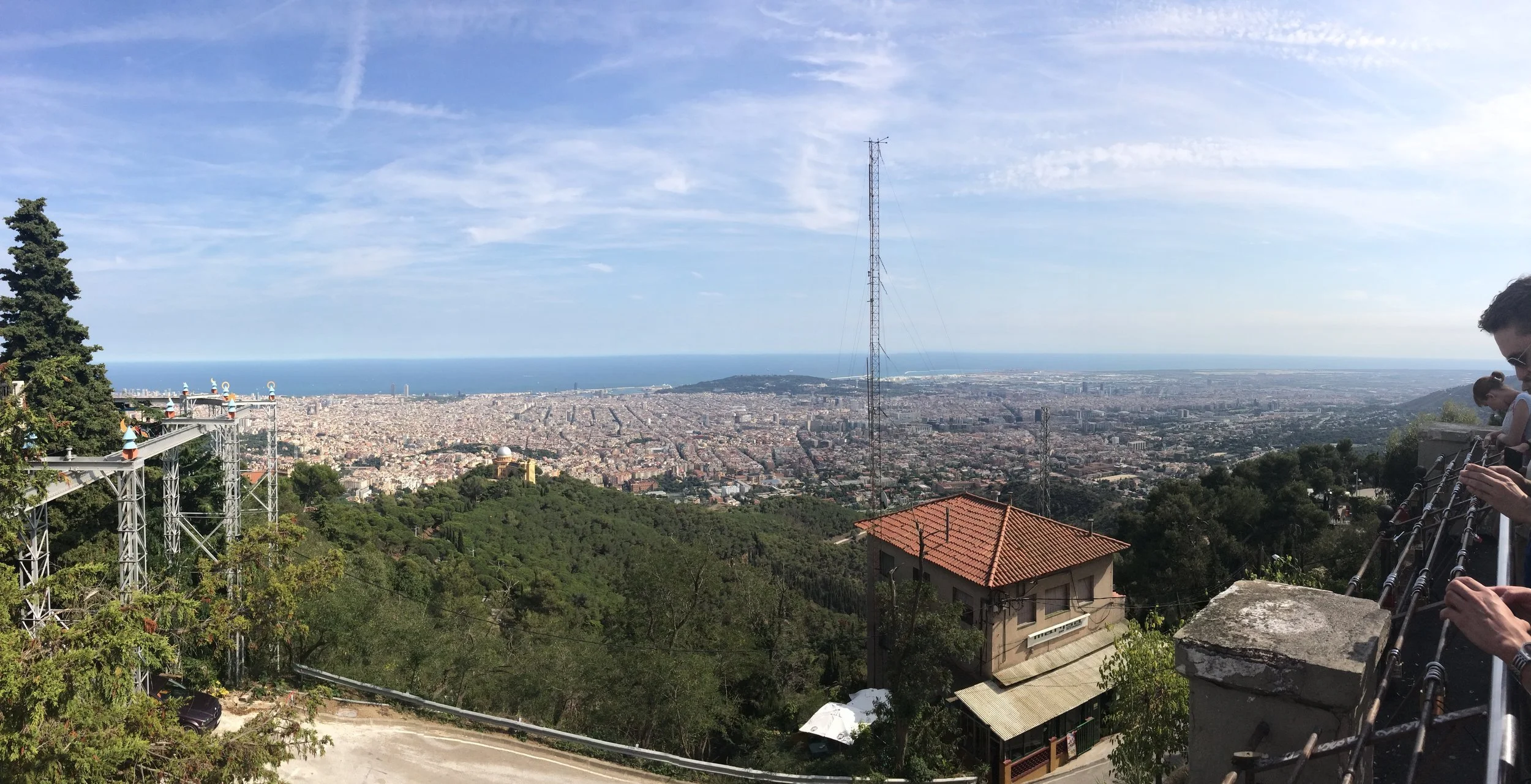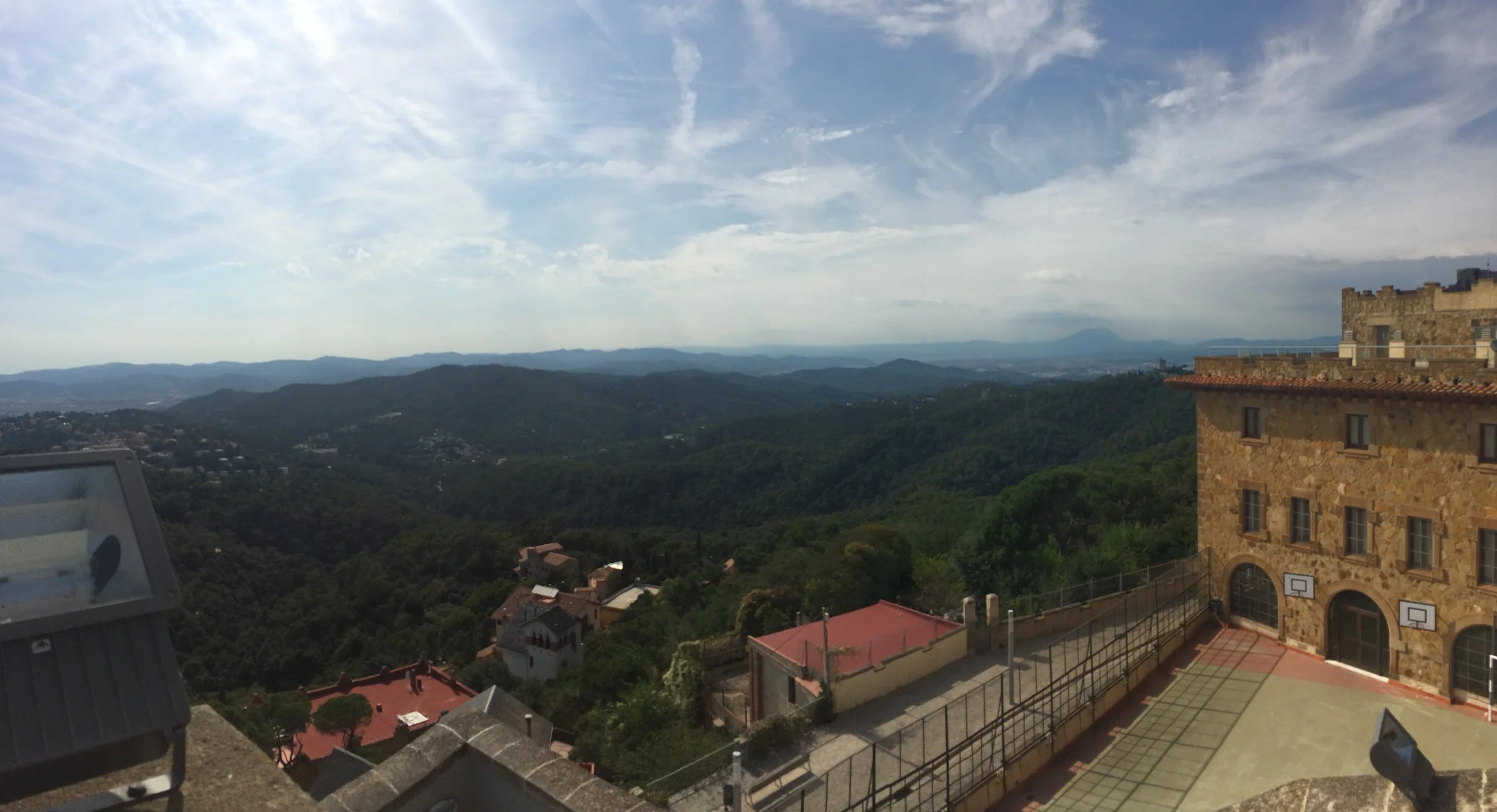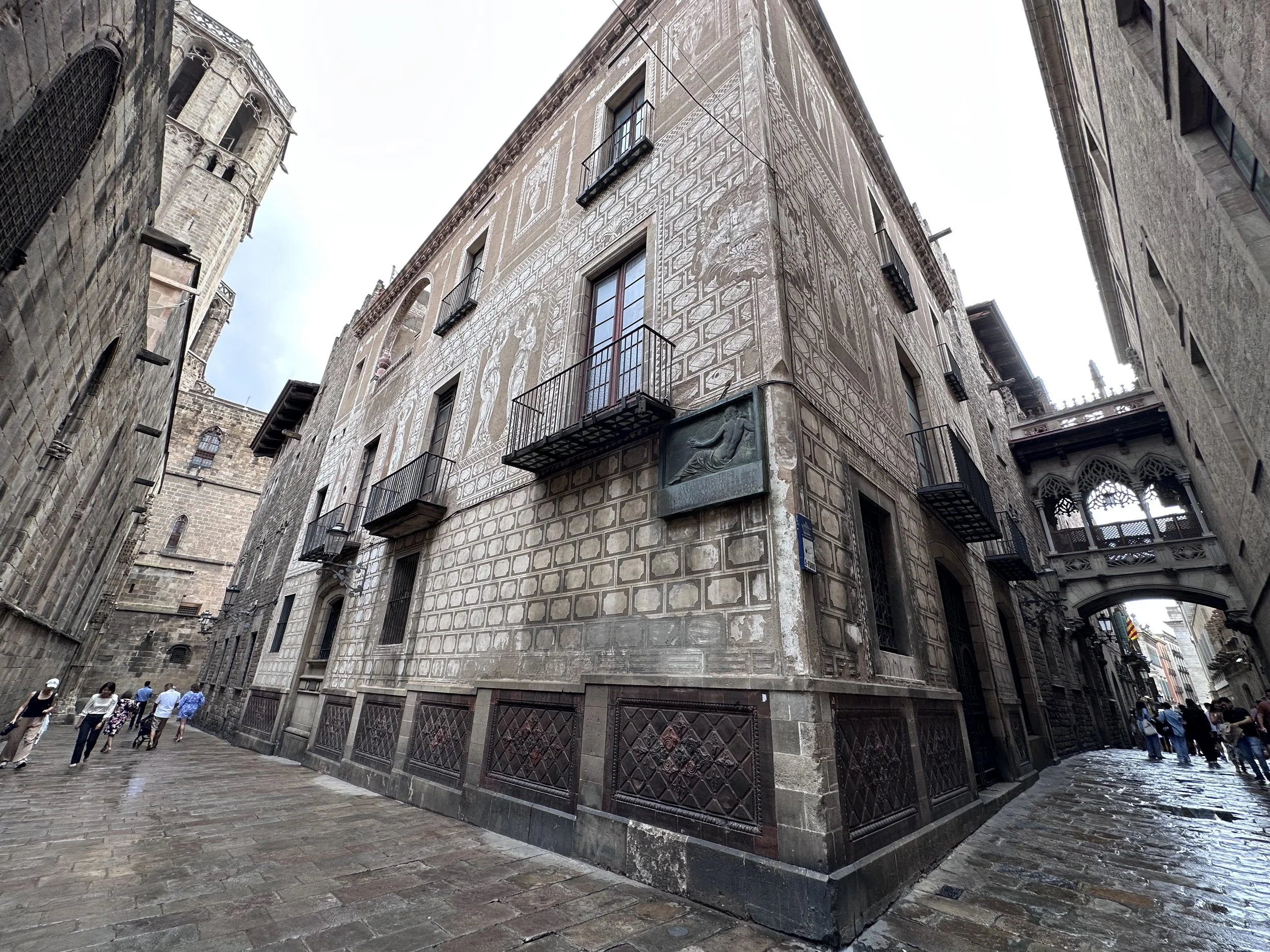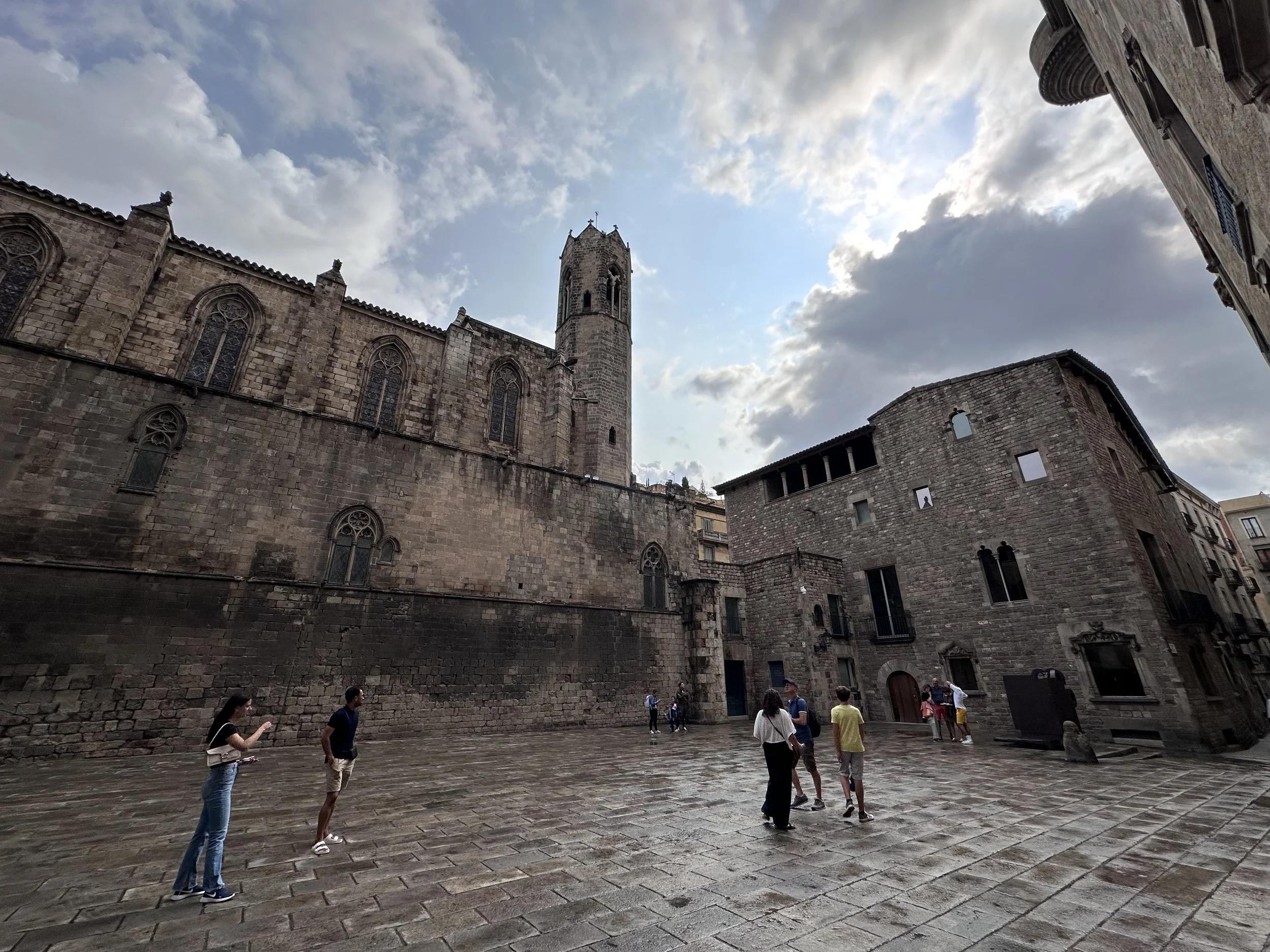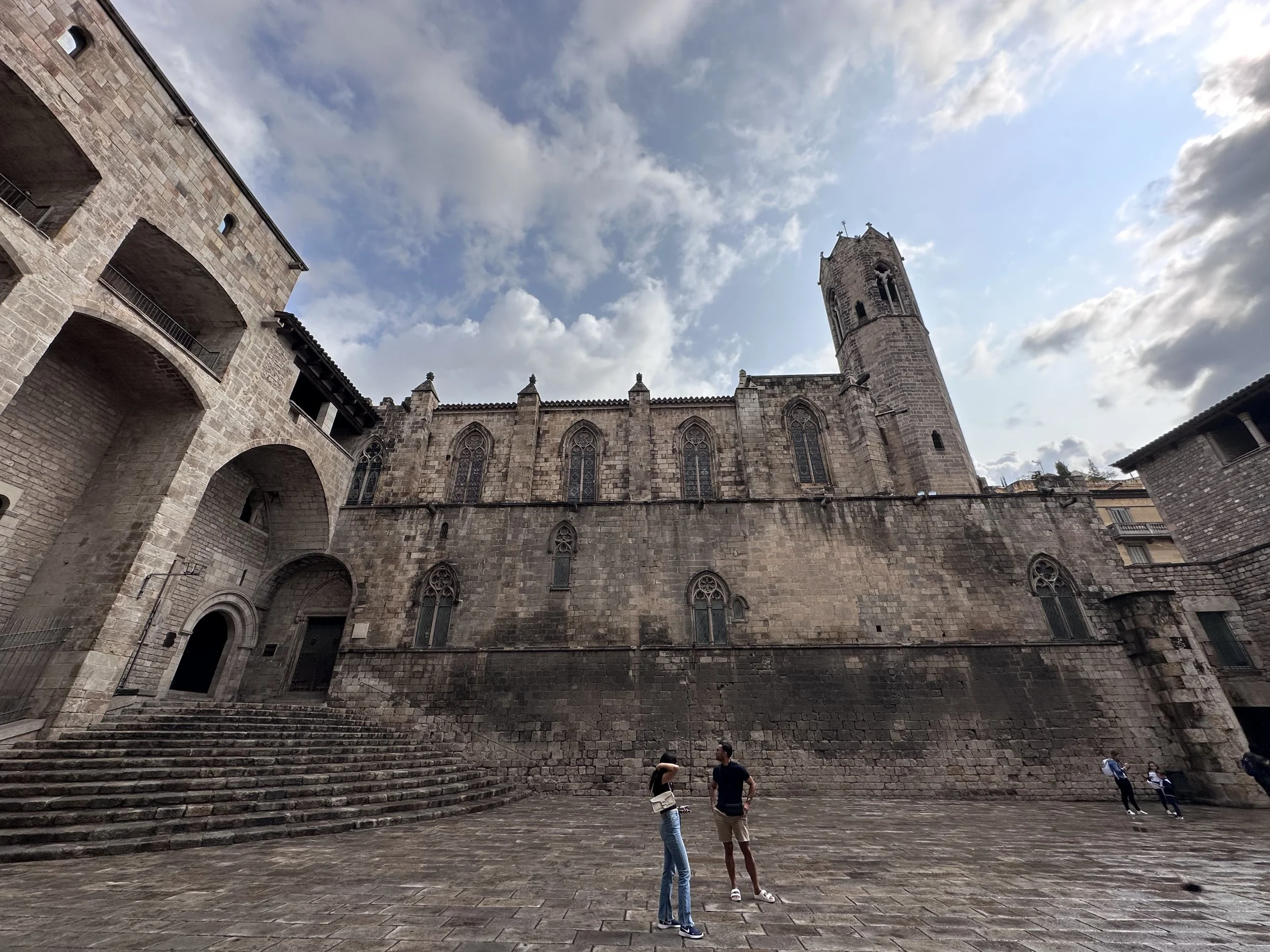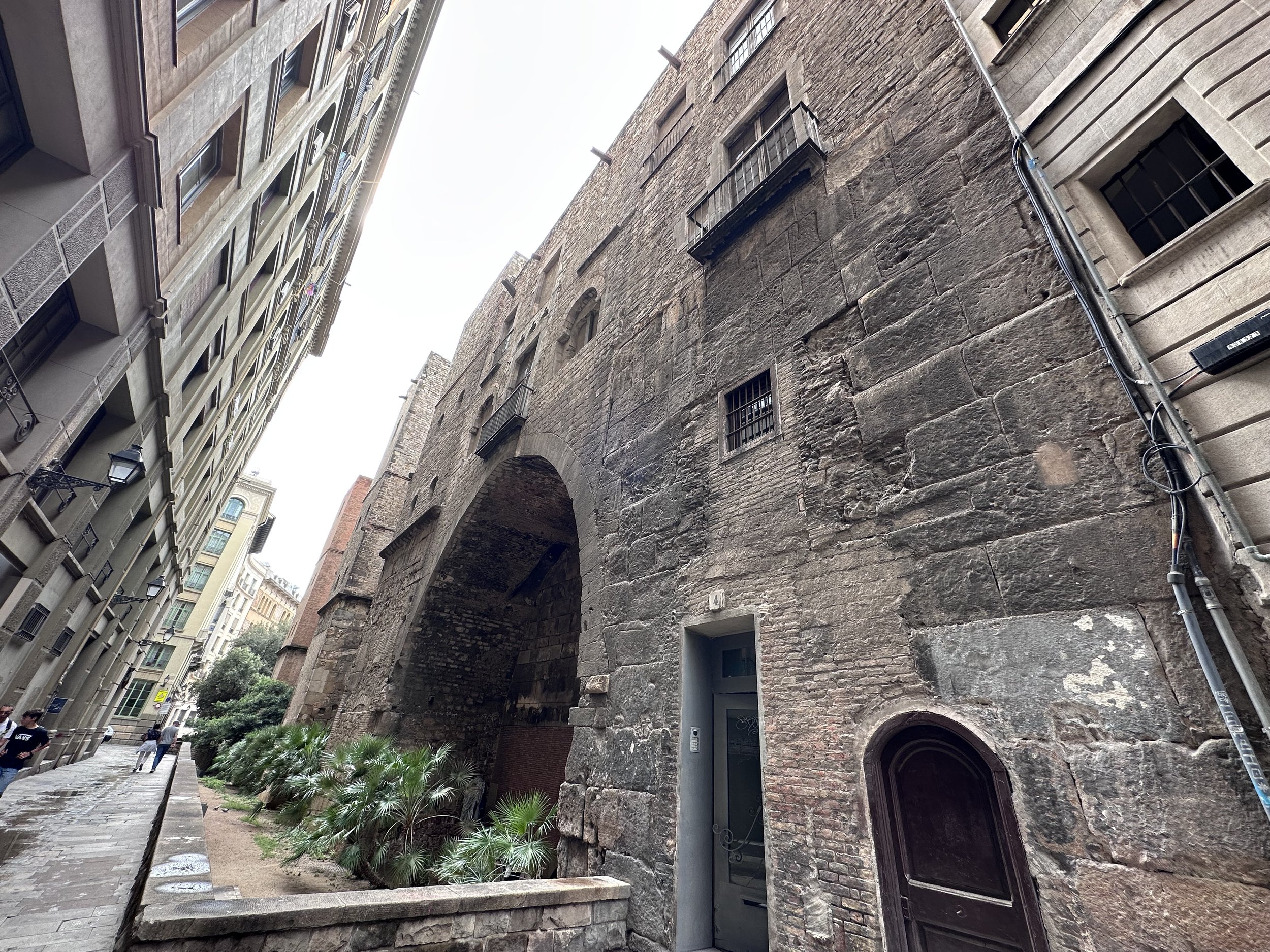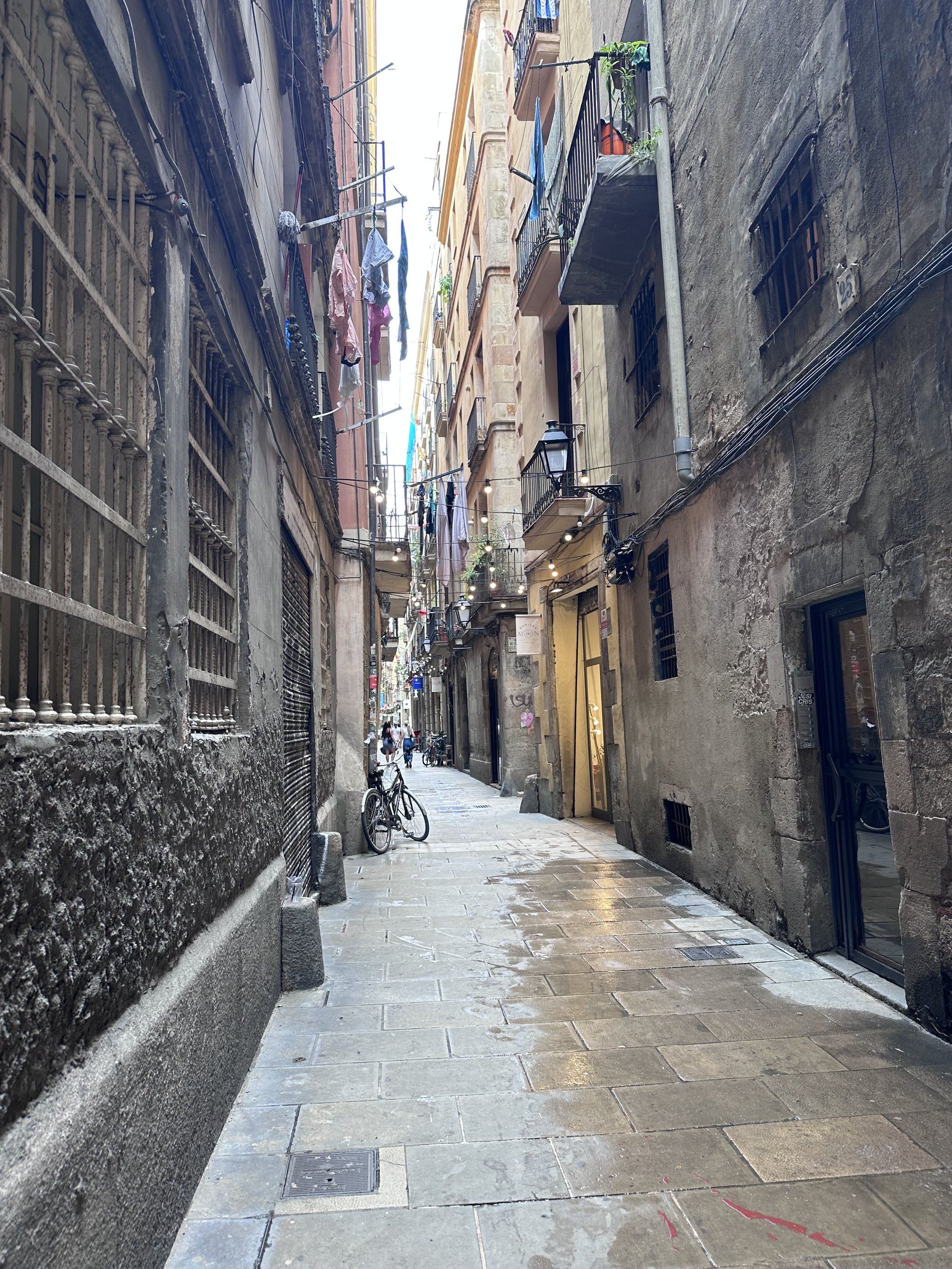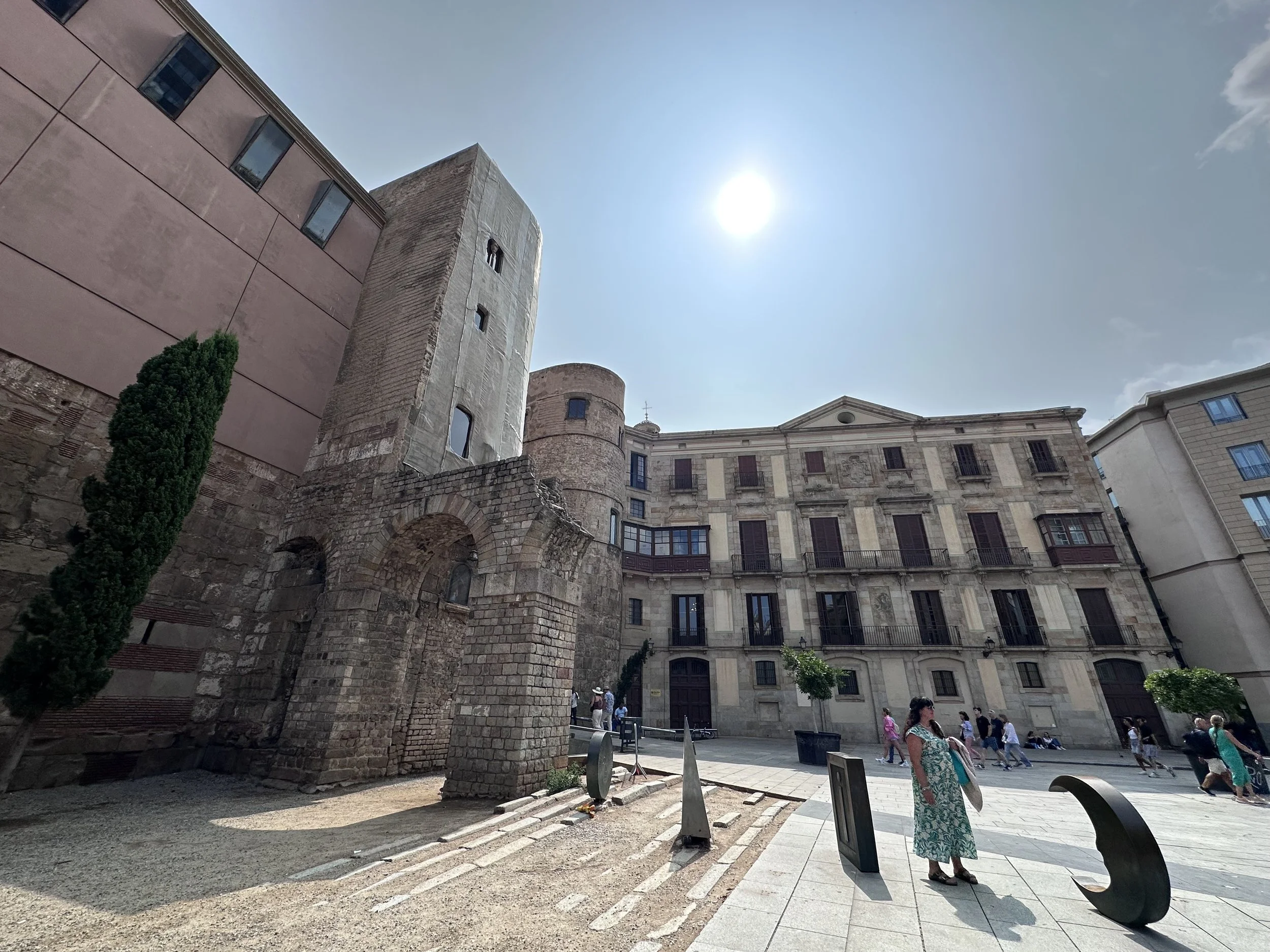Exploring Barcelona, Spain
Note: This post has been updated on June 16, 2023.
Time needed in this city: 2-3 nights (more if you are taking day trips)
Barcelona is one of those cities you fall in love with for Antoni Gaudi’s architecture, but only need a few days to explore.
The below information is a complete guide of the best places to stay, the top rated places to dine and drink, and all there is to see and do. We’ve also included transportation tips, as well as a summary of the history of this beautiful city!
Jump To:
Where to Stay
Below are the best areas to stay, along with a list of hotels in each area. Certainly, there are hotels everywhere, all over the city however, we want to give you the best areas, with the best hotels, with the best ratings.
Dreta De L'Eixample
Gothic Quarter
La Barceloneta (Marina/Beach)
Where to Dine & Drink
There are so many places to eat around this vast city, that it can oftentimes be hard to narrow it down. We’ve chosen a list of restaurants that have 4.5+ stars, in a variety of popular areas, in Barcelona:
Dreta De L'Eixample
Age of Aquarius
Upscale, plant-based restaurant with a near 5-star rating.
A Vocados Gluten Free
A dedicated gluten-free/vegan restaurant
Besta
Michelin-rated restaurant, serving Mediterranean and Atlantic seafood.
Casa Amàlia
Traditional Catalan cuisine
Compartir
Mediterranean eatery in an upscale setting
EatMyTrip - Brunch & Bakery Barcelona
Known for inventive foods, such as Eggs Benedict spiced up with Penang curry sauce, plus hot sandwiches, cocktails, & renowned pancakes.
Faire. Brunch & Drinks
Vegetarian and vegan fare.
La Browneria
A 5-star, dedicated gluten-free bakery
Lasarte
A three Michelin-starred restaurant serving creative Spanish dishes with tasting menus.
Moments
A two Michelin-starred restaurant, located in the Mandarin Oriental, they serve Catalan dishes.
Oria
A Michelin-starred restaurant in the lobby of the Monument Hotel, presenting innovative Basque cuisine.
Pizza natura saludable y sin gluten
A dedicated gluten-free pizza place
Prodigi
Contemporary Catalan cuisine
PUR
Chic, understated venue offering elegantly plated grilled meat & seafood, plus a robust wine list.
Uma
Tasting menus of creative gastronomy & wine pairings in an intimate room with quirky artwork.
El Poble Sec
Alapar
Serving Mediterranean Izakaya dishes
Denassus
Intimate eatery with sidewalk tables presenting reimagined tapas & mains, plus a robust wine list.
La Chana
Bar + Andalusian cuisine
La Platilleria
Neighborhood tapas place
Malevo
Tapas bar
O Meu Lar
Tapas, charcoal-grilled meats & suckling pig in a simple tavern with exposed bricks & wooden tables.
Quirat
A Michelin-starred restaurant in the Intercontinental, serving artful Spanish tasting menus.
Restaurant Bar Celona
Spanish comfort food
Restaurante Mano Rota
Seasonal, inventive fusion dishes & Spanish wines in a stylish space with exposed brickwork.
TAiTU
Sophisticated Ethiopian eatery serving traditional fare with vegan options in a warm, vibrant space.
El Raval
Alkimia
A Michelin-starred restaurant serving tasting menus showcasing contemporary Catalan cuisine in a chic space with aquatic-themed decor.
Cañete
Spanish dishes and wine
Cera 23
Rustic setting for artfully plated, creative Spanish cuisine, including a black rice "volcano."
Dos Pebrots
Serving a twist on Mediterranean cuisine
Fonda España
Creatively presented tasting plates & mains in an elegant space with intricate art & vintage lamps.
Suculent
Creatively reinterpreted Spanish meat & fish dishes in a retro-chic space with recycled furnishings.
Gothic Quarter
While this doesn’t have the highest reviews, due to service, it is one of the oldest restaurants in Barcelona (opened since the 1800s) and is known for their large paella.
Caelis
High-end Spanish, pre-fixe menus
Capet
Refined Spanish fare & an ample wine list offered in a chic, contemporary space.
Contraban
French cuisine in a secret setting at the Wittmore Hotel
Direkte
With nearly a perfect rating, they are a tiny and unusual eatery beneath the arcades of the famous Boquería market, offering a fusion of Catalan recipes, Mediterranean ingredients and Chinese and Japanese cuisine.
El Japonés escondido
Japanese/Spanish fusion
El Xampanyet
Tapas and wine
Gilda by Belgious
Serving Mediterranean dishes & tapas, plus Belgian-style steaks & mussels
Gourmet Sensi
Gourmet tapas
Koy Shunka
A Michelin-starred restaurant serving Japanese fusion
La Cerería
A small restaurant serving vegan and vegetarian dishes
La Selva
Sophisticated restaurant with a jungle theme offering dry-aged steaks, seafood & wine. We recommend the mini baked potatoes, the steak, and the mango dessert!
Le Bistro Sensi
Simple French fare
Manduca Corner
A dedicated gluten-free restaurant
Méson del Café 1909
We stumbled across this tiny place (one of the oldest running cafes in Barcelona), nestled down an alleyway in the Gothic Quarter, an we ended up having the best cappuccino we have ever had. Definitely pop in between the sites!
Check out our video short, here.
Milk Bar & Bistro
A large, fusion menu, known for its brunch and livelier atmosphere.
Petit Tapas
Serves traditional tapas and is only open for dinner.
L'Antiga Esquerra de L'Eixample
Albé (Top rated!)
Lebanese/Spanish fusion
Angle
A two Michelin-starred restaurant serving seasonal tasting menus
Atempo
A Michelin-starred restaurant serving contemporary cuisine
Brugarol Barcelona - X
The restaurant serves a selection of tapas made from locally sourced, seasonal ingredients with an Asian twist (note they also have a location in the old Jewish district in the Gothic Quarter).
Deliri
Contemporary Catalan
Disfrutar
A two Michelin-starred restaurant serving experimental tasting menus, specializing in seafood.
La Tartareria
Creative seafood, meat tartares & other raw dishes.
Mont Bar
A Michelin-starred, fine dining restaurant, serving tapas and wine.
Nairod
Specializes in game dishes
Paco Merlago
Serving tapas
Tunateca Balfegó Espai Gastronòmic
Serving Bluefin tuna sushi, carpaccio & cooked dishes, with tasting menus, in a sleek, high-design space.
Les Cort de Sarriá
Batea
Seafood bar
Cocina Hermanos Torres
A three Michelin-starred (and one green-starred) restaurant where diners can collaborate with chefs on their own refined tasting menus.
La Mundana
Spanish tapas with an international twist, like Korean ribs & Iberian tonkatsu, in a sleek space.
Las Muns
Serving a wide variety of empañadas
Majide
Japanese
Pepa Bar a Vins
Tapas and wine bar
Punta Anguila
Mediterranean cuisine
RAO
Edgy, brick-walled space with a terrace, serving ceviche, seafood & innovative Spanish cooking.
Restaurante Hofmann
A Michelin-starred restaurant serving Catalonian cuisine.
SUTO
With nearly a five-star rating, it serves modern Japanese dishes.
Via Veneto
A Michelin-starred restaurant that has been around for over 50 years. To an elegant and genuine Belle Époque backdrop, you can dine on a variety of dishes, including seasonal game. You can also visit their wine cellar, which is 6m underground. It’s been noted that one of the most famous dishes is the pressed roast duck cooked in its own jus, which has been featured on the menu since 1967!
San Antoni
19 Bagels
An amazing amount of reviews for their gluten-free bagels
Bandini’s
Andalusian/Scandinavian fusion
Benzina
Italian
Doppietta
Italian
Enigma
A Michelin-starred restaurant focused on “fun dining”, where guests can choose small, yet unique snacks, tapas, and finger food tailored, with great skill, to their personal tastes.
Maleducat
Tapas and wine
Slow & Low
A Michelin-starred restaurant serving 6-17 course meals.
Teatro kitchen & bar
Varied cuisine in the shape of snacks, tapas, a few classic dishes, plus a surprise selection. Also enjoy a drink in the restaurant’s Backstage Bar.
Vila de Gracia
Aleia
Located in the Casa Fuster Hotel, they are a Michelin-starred restaurant, serving creative cuisine with Asian and French flares.
Berbena
Mediterranean dishes with Asian and South American influences.
Con de Gracia
Mediterranean w/ tasting menus and wine
Glutery
A dedicated gluten-free bakery.
Messié Pizza Gluten Free Gràcia
A dedicated gluten-free pizza place.
Things to See & Do
Day Trips
Girona
To learn more about our incredible day trip there, including how to book your own tour, click on the link above.
Montserrat
To learn more about our incredible day trip there, including how to book your own tour, click on the link above.
Historical Exploration
Barcelona History Museum MUHBA
In 1929, during the Barcelona International Exposition, the municipality organized a temporary exhibition about Barcelona's past, present, and future that constitutes the forerunner of the Museum of the History of Barcelona,
In 1931, Casa Padellàs, a late gothic palace (15th-16th centuries) was moved, stone by stone, from its original location on Mercaders street, to Plaça del Rei, due to the construction of new roads. While rebuilding Casa Padellàs on its new location, some remains of the ancient city of Barcino were found. Immediately, an archaeological research was undertaken in the surrounding area, emerging a whole quarter of the Roman city.
During the Spanish Civil War, while all construction was stopped, though the importance of the findings determined that this location was the most fitting for a historical museum.
The Museum of the History of Barcelona was finally inaugurated after the Spanish Civil War, in 1943. The core of the museum was centered on the archaeological remains of this Roman city, together with the medieval royal palace in Plaça del Rei (Palau Reial Major), which includes the main hall called Saló del Tinell (14th century) and the palatine chapel dedicated to Saint Agatha (14th century). In the rebuilt Casa Padellàs, rooms also exhibit objects from the history of Barcelona, from medieval times, on.
Casa Batlló
Commissioned by Lluís Sala Sánchez and built in 1877, the design of the house made the home undesirable to buyers but the Batlló family decided to buy the place in 1903, due to its centralized location, and also where the prestigious family could draw attention to themselves.
One year later, in 1904, Josep Batlló wanted to design a house that was like no other and stood out as being audacious and creative. Both Josep and his wife were open to anything and they decided not to limit Gaudí in his design ideas, as initially, they wanted to tear down the building they were living in and start anew, and it was Gaudí who convinced them to make proper renovations instead. Two years later, the building was completed and refurbished. This included completely changing the main apartment ,which became the residence for the Batlló family, expanding the central well in order to supply light to the whole building, and also added new floors. In the same year, the Barcelona City Council selected the house as a candidate for that year's best building award, though it was given to another architect that year, despite Gaudí's design.
Josep Batlló died in 1934 and the house was kept in order by the wife until her death in 1940. It was then kept and managed by their children until 1954 when an insurance company acquired Casa Batlló and set up offices there.
In 1970, the first refurbishment occurred mainly in several of the interior rooms of the house and in 1983, the exterior balconies were restored to their original color.
In 1993, the current owners of Casa Batlló bought the home and continued refurbishments throughout the whole building. Two years later, in 1995, Casa Batlló began to hire out its facilities for different events. More than 2,500 square meters of the building’s rooms are rented out for many different functions.
Casa Gispert
Casa Gispert is one of the oldest food stores in Barcelona and have been selling products from overseas, since 1851. This includes nuts, dried fruits, coffee, tea, cocoa, species like vanilla, cinnamon, saffron (but now includes so much more)…and the inside has been kept just as it was when it first opened over 170 years ago.
The store is located down an alleyway, which we’d recommend using Google Maps for to help locate.
We visited the store and holy cow - they sell so many amazing products and even roast their own coffee beans with the original equipment used 170 years ago. We highly recommend you take a few moments to stop in there.
Casa Vicens
In 1878, Gaudí received his first home commission from Manuel Vicens i Montaner (a stock and currency broker) to build a summer residence for the family in the town of Gràcia. The plans were signed by the town council in 1883 and the work was carried out that same year until two years later in 1885. Gaudí personally managed the construction, which, according to the testimony of Joan Baptista Serra to George R. Collins in 1959, the architect sat under a parasol and supervised the build, occasionally knocking down what he considered to be poor workmanship.
The house, designed as a single-family home, had a wine cellar and basement for storage; a main floor with a foyer, dining room, porch, smoking room, kitchen and laundry room; a first floor with bedrooms, bathrooms, a dressing room and a library; an attic for staff accommodation; and a roof terrace with small walkways between the gables with chimneys and a pavilion in the northwest corner. It also had a Catalan vaulted staircase with wooden wainscoting on each step, decorated with small oil paintings by Torrescassana, which were lost in the renovations of 1925.
Gaudí planned a set of masonry walls for the house, alternated with rows of tiles. The tiles would feature yellow flowers typical of the area, which Gaudí had found on the site of the house before construction, and which he wanted to reproduce in the final project. He was also inspired by a palmetto tree he discovered on site and designed the cast iron gate at the main entrance in the shape of palm leaves. As Gaudí expressed, “When I went to take the measurements of the site, it was totally covered with some yellow flowers, which I used as an ornamental theme for the ceramic. I also found an exuberant palmetto palm, whose leaves fill the grid of the gate of the house”.
In 1899, the widow of Manuel Vicens, Dolors Giralt i Grífol, sold the house to Dr. Antonio Jover Puig for 45,000 pesetas. Antonio Jover was a renowned pediatrician, who had graduated from the University of Barcelona in 1876. He was living in Cuba and worked as a professor at the University of Havana, until the island gained independence and he returned to Spain. Thanks to the fortune he accrued in Ultramar, like other returning emigrants of the time, he was able to acquire Casa Vicens. He represented various Spanish commercial interests in Cuba and, even after its independence, returned to spend time on the island. He was also president of the Casino Español in Havana and the Cercle Català. He settled in Barcelona in 1924, was a councillor of the City Council of Barcelona from 1924 to 1930 and deputy mayor with Darius Rumeu i Freixa, Baron of Viver. In 1908, Dr. Jover sold the house to his brother, José Jover, maintaining usufruct of the property. When he died without issue in 1913, he left it to Ángela González Sánchez, Antonio Jover’s wife.
In 1925, Dr. Jover planned an extension of the building with the aim of turning it into his principal residence. For this, he acquired 718 sq.ft. of land adjacent to the wall shared with the convent. He also acquired the land located between the narrow street of Carreró Racó de Sant Gervasi and Avinguda de la Riera de Cassoles, and he was able to have the alleyway declared an unused public thoroughfare, with which he could expand the garden into that area. With this, the property had reached its maximum size of 5,702 sq. ft. He approached Gaudí to lead the project to extend the house, but he declined, as he was devoting himself fully to the Sagrada Família at the time. Instead, he recommended one of his protégés, Joan Baptista Serra, who designed the right half of the facade in the style of Gaudí.
In 1927, Casa Vicens won the Best Building Award by Barcelona City Council, due to the renovations and extension carried out by Joan Baptista Serra. Eight years later in 1935, the building underwent a new extension when a new area to the ground floor was added. In 1946, part of the garden was sold for the construction of houses, which demolished the waterfall and the old viewpoint.
In 1962, Dr. Jover’s widow, Ángela González Sánchez, passed away, leaving her children, Antonio, Gaspar, María de la Paloma and Fabiola as heirs. After the distribution of her assets, Casa Vicens was left to Fabiola, who was married to gynecologist, Antonio Herrero López, who had his clinic at Casa Vicens. The following year, in 1963, another part of the garden was sold for the construction of houses and the chapel of Santa Rita was demolished. In addition, most of the palmetto fence was dismantled, though some portions have been placed at various points in Park Güell. The property was then left at its current size, and architect Antonio Pineda Gualba was commissioned to renovate the basement and the ground floor, which was carried out in 1964.
The house was restored in 1997 and was as mainly carried out on the facades and roof.
In 2001, upon Fabiola’s death, the inheritance was passed to her sons Antonio, Ignacio, Carlos María and Javier Herrero Jover. 13 years later, they sold the home to the Andorran bank, MoraBanc, which turned the property into a house-museum after its renovation. It opened its doors to the public on November 16, 2017.
La Pedrera
Casa Milà, or as the locals call it, “La Pedrera” (stone quarry) is one of Gaudí’s many buildings across Barcelona.
Pere Milà (a flamboyant developer) and his wealthy wife Roser Segimon (she gained her money from her late first husband who had a Guatemalan coffee bean farm) hired Gaudí to design them a new house with the idea of living in the main floor and renting out the rest of the apartments. On February 2, 1906, the project was presented to the Barcelona City Council and the works began, demolishing the pre-existing building instead of reforming it, as in the case of the Casa Batlló
The building was completed in December 1910 and the owner asked Gaudí to make a certificate to inhabit the main floor, which the City Council authorized in October 1911, and the couple moved in. On October 31, 1912, Gaudí issued the certificate stating that, in accordance with his plans and his direction, the work had been completed and the whole house was ready to be rented.
In 1940, Pere Milà died and six years later, Roser Segimon sold the property for 18 million pesetas to Josep Ballvé i Pellisé, known for his department stores on Ronda de Sant Antoni, in partnership with the family of Pío Rubert Laporta. The Compañía Inmobiliaria Provenza, SA (CIPSA) was founded to administer the building, and Roser Segimon continued to live on the main floor until her death in 1964.
The new owners divided the first floor, facing Carrer de Provença, into five apartments instead of the original two. In 1953, they commissioned Francisco Juan Barba Corsini to convert 13 rubbish-filled attic laundry rooms into street-facing apartments, leaving a communal hallway on the side facing the courtyards. These 2-3 room apartments had a loft and were designed and furnished in a typical early 1950s style using brick, ceramic, and wood.
The insurance company, Northern, took over the main floor in 1966. By then, Casa Milà had housed a bingo hall, an academy, and the offices of Cementos Molins and Inoxcrom (among others). In 1971, maintenance costs were high and as such, the owners had allowed the building to become dilapidated, causing stones to loosen.
On July 24, 1969, Gaudí's work was designated a historic and artistic monument, though Casa Milà was in poor condition into the early 1980s. It had been painted a dreary brown and many of its interior color schemes had been abandoned or allowed to deteriorate (until the restoration in the late 1980s).
In 1984, the building became part of a World Heritage Site and two years later, one day before Christmas 1986, Caixa Catalunya bought La Pedrera for 900 million pesetas. On February 19, 1987, work began on the restoration and cleaning of the façade. The main floor was renovated shortly after and reopened in 1990 as part of the Cultural Olympiad of Barcelona.
As of now, there are only three residents left in the building - the contracts were for four generations only. There’s no say on what will happen to the apartments after that.
TIP: Schedule the night tour of La Pedrera as the rooftop views and the clear view of the Sagrada Familia is worth it!
NOTE: If you see the night tour, you no longer see the apartment with it. If you want to do that, take the day tour. As we learned, you can also purchase the day tour at a discount if you have the night ticket.
Montjuïc Castle
In 1640, the foundation stone for the basic fortification was laid out.
A year later, in January 1641, the fort saw its first battle, during the Catalan Revolt. On orders from the King of Spain, Pedro Fajardo, he lead an army of 26,000 men to crush the revolt. The Spanish recaptured several cities, but they were defeated at the Battle of Montjuïc by Catalan. At that battle, Colonel Shane O'Neill or known in Spain as “Prince Juan O'Neill”, died leading his regiment during this battle. In his honor, the King of Spain granted the Colonel the death title of “Viscount Montjuïc”.
In 1694, new bastions and battlements were erected and the fortress became a castle.
In the Siege of Barcelona (1705) the fortress was captured by the British 6th Regiment of Foot led by Lt.-Col William Southwell, paving the way for the siege of Barcelona itself. Southwell was afterwards made Governor of the castle.
In 1751, the old fort was demolished by the Spanish engineer and architect, Juan Martin Cermeño, creating the current structure that still stands today.
The final shape of the castle took form between 1779 and 1799, when major construction works took place in order to improve the castle and its accommodations. It was also during this time that the castle was equipped with 120 cannons.
During the Napoleonic Wars, the French Army entered Barcelona and, on orders from Napoleon, captured the castle without firing a shot, as the troops guarding the castle were ordered not to fight the French.
In the last 350 years, Montjuïc Castle has played a decisive role in the history of Barcelona, becoming a symbol after the Catalan defeat to Spain in 1714. Since then, the Montjuïc cannons have bombarded the city and its citizens on various occasions. The castle, itself, has been used as a prison and torture center, repeatedly, for three centuries, including the late 19th century when it became synonymous with barbarism, based on the torture of anarchists and others imprisoned there; and from 1936 to 1940, when prisoners from both sides of the Civil War were tortured and shot.
About 20 years later, the castle became a military museum.
Roman City Walls
In the Plaça Ramón Berenguer (town square), behind the equestrian sculpture depicting the Catalan count, there is a section of the 4th century Roman wall crowned by the Gothic chapel of Santa Àgata (14th century). While this section is considered the “second wall” (the first walls were from 1 AD and were built using weaker materials, thus a second wall needed to be built). It originally had 74 towers, was 16 metres (52 feet) high, and marked the perimeter of the early city, which was 1.3 kilometres (.8 miles) in circumference.
Sant Pau Art Nouveau Site
The former Hospital de la Santa Creu i Sant Pau is a complex built between 1901 and 1930. The complex was listed as a Conjunto Histórico in 1978, and together with Palau de la Música Catalana, it was declared a UNESCO World Heritage Site in 1998.
Composed of 12 pavilions connected through long underground galleries, within its large green space, Sant Pau is the largest complex built in Art Nouveau style. It was a fully functioning hospital until June 2009, when the new hospital opened next to it.
It underwent restoration for use as a museum and cultural center, and re-opened in 2014. An important historical and architectural masterpiece, the building also offers workspace to high-profile social organizations such as WHO, Banco Farmacéutico, Barcelona Health Hub, EMEA, UN-HABITAT and more. The cultural center also has a historical archive where records and documents of remarkable occurrences, related to the hospital and the city, can be found.
Temple d'August
Nestled down an alleyway in the Gothic Quarter is Temple d’August (Temple of Augustus) - one of the hidden wonders of Barcelona.
Built in the first century B.C., the temple was built for Emperor Augustus,. It was 37 metres long (121 feet) and 17 metres (55 feet) wide, though today, you are only able to see the columns, which each stand about 9 metres tall (29.5 feet).
Religious History
Built between 1329 and 1383, this gothic cathedral was considered an example of the height of prominence of the merchant town.
Backed by the townspeople, construction work started on March 25, 1329, when the foundation stone was laid by king Alfonso IV of Aragon as commemorated by a tablet in Latin and Catalan on the façade that faces the Fossar de les Moreres. The walls, the side chapels, and the façades were finished by 1350. In 1379, there was a fire that damaged important parts of the works however, on November 3, 1383, the last stone was laid and on August 15, 1384, the church was consecrated.
In 1428, the Catalonia earthquake caused several casualties and destroyed the rose window in the west end. The new rose window was finished by 1459 and one year later, the glass was added.
In 1936, sadly, many of its decorative richness - the images and the Baroque altar - were destroyed in a fire set by anti-clerical rioters at the beginning of the Spanish Civil War. The church survived even though it was on fire for 11 days.
Out of all the churches and cathedrals I have seen in my years of travel, this one is the best example of Gothic style, straight down to the centuries of soot. It is absolutely a “must” go-see.
TIP: If you have time before you go, read Cathedral of the Sea - while the story is fictional, the timeline of the basilica being built is real. It brings to life all of Barcelona when you are touring it!
Cathedral of Barcelona
In 1046, Count Ramon Berenguer I and his wife Almodis, together with Bishop Guislabert, began construction of a Romanesque cathedral, and was consecrated in November 1058.
The present Gothic cathedral was begun on the foundations of the previous churches on May 1, 1298 and was completed in 1417. In 1448, the cloister was completed, making the total duration of construction 150 years.
In the late 19th century, Miguel Girona i Agrafel offered to complete the neo-Gothic facade and central tower as inspired by the original 15th century design prepared by master Carlí and rearranged and drawn by the architect Josep O. Mestres. This work was completed in 1913 by Girona's children.
NOTE: When you buy your ticket in their offices, you get add-ons, such as the museum and the terrace. We saw a whole Matisse collection and while we were super excited about the terrace, it was closed due to rain.
Sagrada Familia
The Sagrada Família was inspired by a bookseller, José María Bocabella, founder of Asociación Espiritual de Devotos de San José (Spiritual Association of Devotees of St. Joseph). After a visit to the Vatican in 1872, Bocabella returned from Italy with the intention of building a church inspired by the basilica at Loreto. The apse crypt of the church, funded by donations, began construction on March 19, 1882, on the festival of St. Joseph. The apse crypt was completed one year later, which is also when Antoni Gaudí assumed responsibility for its design (changing it drastically in the process), though was not appointed Architect Director until 1884.
Gaudí devoted the remainder of his life to the project and he is buried in the church's crypt. At the time of his death in 1926, less than a quarter of the project was complete.
Relying solely on private donations, the Sagrada Família's construction progressed slowly and was interrupted by the Spanish Civil War. In July 1936, anarchists from the FAI set fire to the crypt and broke their way into the workshop, partially destroying Gaudí's original plans. In 1939, Francesc de Paula Quintana took over site management, which was able to go on due to the material that was saved from Gaudí's workshop and that was reconstructed from published plans and photographs. In the 1950s, construction resumed with intermittent progress, and as technology advanced, such as computer-aided design and computerized numerical control (CNC), faster progress and construction passed the midpoint in 2010. However, some of the project's greatest challenges remained, including the construction of ten more spires, each symbolising an important Biblical figure in the New Testament.
It is set to be completed by 2026 on the anniversary of Gaudí’s death.
TIP: I recommend booking the Passion Tower tour (the Nativity Tower tour is limited in views, which you will see in the video above). You get some incredible views of the city and of the Mediterranean. Also consider going in the evening between 6-9pm so you can tour the crypts and pay respects to Gaudí.
TIP: To book skip the line tickets, click here.
The Arts & Sciences
Ayrton Senna Sculpture
Created by a British sculptor for the Spanish Grand Prix. Interestingly, Aryton is a Brazilian-born racer.
MOCO Museum
The Moco Museum is an independent museum with a wide range of inspiring modern, contemporary, and street art – located in Amsterdam and Barcelona. Their exhibits include works from Jean-Michel Basquiat, Banksy, Icy & Sot, JR, KAWS, Keith Haring, Jeff Koons, Damien Hirst, Tracey Emin, Yayoi Kusama, THE KID, Andy Warhol, Studio Irma, and many more.
We’ve also been to the one in Amsterdam and it’s hard to compare. They both have different collections by the same artists, both really fun to walk through.
Museu Nacional d'Art de Catalunya
The history of the museum dates back to the 19th century when, in accordance with the principles that inspired Catalonia's cultural and political renaissance, many projects were launched to help revive and conserve the country's artistic heritage. This process began with the establishment of the Barcelona Museum of Antiquities in the Chapel of St Agatha (1880), and the Municipal Fine Art Museum in the Palau de Belles Arts (1891).
The Palau Nacional, which has housed the Museu d'Art de Catalunya since 1934, was declared a national museum in 1990 under the Museums Law passed by the Catalan Government.
Since 2004, the Palau Nacional has once more housed several magnificent art collections, mostly by Catalan art, but also Spanish and European art. The works from that first museum have now been enriched by new purchases and donations, tracing the country's art history from early medieval times to the mid-20th century: from Romanesque, Gothic, Renaissance and baroque to modern art.
Palau de la Música Catalana
Built between 1905 and 1908, for Orfeó Català, a choral society founded in 1891, the “Palace of Catalan Music” is a concert hall now designated as a UNESCO World Heritage Site.
Between 1982 and 1989, the building underwent extensive restoration, remodeling, and extension. In 1997, the palace de la Música Catalana was declared a UNESCO World Heritage Site along with Hospital de Sant Pau. Today, more than half a million people a year attend musical performances in the Palau that range from symphonic and chamber music to jazz and Cançó (Catalan song).
Picasso Museum
Opened on March 9, 1963, the Museu Picasso houses an extensive collection of artworks (a little over 4,250) by Pablo Picasso. It is housed in five adjoining medieval palaces on Montcada Street, in the La Ribera neighborhood, in the Old City of Barcelona. It was the first museum dedicated to Picasso's work (it’s sister museum is in Paris) and was the only one created during his lifetime.
Highlights of the collection include two of his first major works: The First Communion (1896) and Science and Charity (1897). In particular, the Museu Picasso reveals Picasso's relationship with the city of Barcelona - a relationship that was shaped in his youth and adolescence, and continued until his death.
"The World Begins With Every Kiss" Mural
Near the Catedral de Barcelona, this mural was only meant to be a temporary exhibition. It was unveiled in 2014 for the 300th anniversary of September 11, 1714, a day known as Catalonia Day, or La Diada, which commemorates the Catalan surrender in the War of Spanish Succession. The day is a tribute to the Catalan lives lost, to regional identity, and to freedom. The mural is made up of 4,000 tiles with photos printed on them arranged into mosaics by color and density so that, from afar, the 26-foot-tall mural shows two people kissing. This kiss—a symbol of affection, empathy, and liberty—felt so poignant that the local government never took it down.
Unique Experiences
Mirador torre Glòries
Possibly Barcelona’s most famous landmark, the Mirador Torre Glòries opened in 2005 and stands 470 ft. tall. It was most famous for housing Meta’s Barcelona outpost until 2022, when the 30th floor became a panoramic public observation deck with unobstructed views across every angle of the city.
Before heading to the top, also visit Hyperview Barcelona in the building. It takes big data recorded that day in the city (number of flights from the airport, how many stars are really visible at night, the geography of where Tweets were sent from, etc.) and turns those facts into audiovisual art.
In addition to the view and the aforementioned exhibit, there’s also a climbing frame, suspended in the air by 3.7 miles of tensioned cable, made of tiny platforms–many transparent–that you climb onto, with absolutely no safety protection. Some platforms have cushions to rest and savor the view, while others are physically tricky to traverse. Note that the regulations of who can climb are strict - you must be over 12 years old, no open shoes, skirts or delicate fabrics are allowed; and if you’re pregnant or have respiratory issues, heart problems, or vertigo, you should pass on this as well.
Tibidabo
Amusement Park
On June 16, 1900, work began on creating access to the top of Tibidabo, with the building of a tram - known popularly as the “Tramvia Blau” (Blue Tram), and a funicular railway.
Just one year later, on October 29, 1901, the new facilities were officially opened. Interestingly, the funicular railway turned out to be the first main attraction of the Amusement Park, due to it being an innovative means of transport at that time. That same year, the first leisure facilities also appeared - such as the automatic scales and postcard vending machines.
The first decade saw the introduction of small attractions, such as telescopes and binoculars, swings, the Flobert shooting gallery, bowling, mirrors, automatons, the carrier pigeon station, along with events of all kinds: including Clavé choirs, military bands, orchestras and balloon rides. New buildings were opened such as the Gran Café Restaurant Tibidabo and the Hotel Restaurant Coll as well as a large events hall, within which they tried, unsuccessfully, to open a casino.
By 1910, the amusement park expanded to include an electric carousel.
In 1913, a Senegalese tribe were hired to show off their costumes, way of life and skills.
In 1915 and for the next 10 years, the park continued to expand and improve on their access to the park.
In 1928, the Avió airplane ride was opened, starring a replica of the plane that made the first Barcelona-Madrid flight. By this time, the Amusement Park had become widely known as the “eighth wonder”.
Though in 1936, as with so much else, they were impacted by the war, offering smaller-scale amusement, such as minigolf and electric cars.
In 1948, a Cypress tree maze was added and its buildings were revived to re-attract scores of visitors.
In 1959, the park was in full swing, adding the Cable Car, Flying Pots, Miniature Train (a replica of Spain's first Barcelona-Mataró railway line), Electric Cars, House of Surprises, Haunted Castle (among others).
In 1961, Tibidabo received its first roller coaster, in addition to a Big Wheel, Bumper Cars, Combat Saucers, Sunflower, and Coffee Game. Meanwhile, indoor amusements also appeared, such as the Tontilàndia Express, the Palace of Light with its crazy mirrors, and Tibicar.
In 1970 and for the next decade, the Amusement Park was again expanded with new terracing that made way for the Indianapolis go-kart track. They also added the Horse Ride, Glass House, Tralla, Mini-Motorway and Scalextric.
To help alleviate parking problems, a new car park was built in 1978 to hold up to 500 cars.
In 1979, Blue Tram number 4 was turned into a souvenir shop at the main entrance to the Park and the first mascot was introduced - a friendly witch called "Pirula".
In the 1980s, a lot of renovation and restoration work began, in addition to the new attractions, such as the Superslide, Trans-Mobile Drag Lift, 180º Cinema, Sínia Big Wheel, Super Bumper Boats, Tibi-Trains, Trampolines, Billagolf, Setidabo, Space Ship, Twister, and MotoSchoppers. This decade also saw exciting acrobatic shows, the creation of the Automaton Museum, and an exhibition of poisonous snakes.
In 1986, a fence was put around the Amusement Park and an entrance fee was charged at the gate for the first time.
In the 1990s, the continual expansion, coupled with financial mismanagement, bankrupted the holding company, though the park continued to operate and even expand - especially during the 2000s when the government agreed to look after it during sale.
In the next two decades, the park has received significant modernization and continues to add bigger and better rides.
Temple Expiatori del Sagrat Cor
The idea of building a Catholic church on the summit of the Tibidabo emerged in the late 19th century amidst rumors about the construction of a Protestant church and a hotel-casino at that location. This motivated a "Board of Catholic Knights" to acquire the ownership of the field and give it to Saint John Bosco in 1886, when he was visiting Barcelona at the invitation of Dorotea de Chopitea, a great patron and promoter of the project. From this arose the idea of a building dedicated to the Sacred Heart of Jesus, a dedication very popular at that time, thanks to the impetus given by Pope Leo XIII, and following in line with the church built in Rome by Bosco himself (Sacro Cuore di Gesù a Castro Pretorio) and the famous Sacré-Cœur in Paris.
In 1886, a neo-Gothic hermitage was built and two years later, for the Universal Exposition, the Vallvidrera road was urbanized and a pavilion was built beside the hermitage to serve as a viewing point (for the city below). However, the project to build the church suffered a significant delay mainly because of the development of a new project to build an astronomical observatory on the summit of Tibidabo, which was eventually constructed on a nearby hill (Fabra Observatory). Finally, on December 28, 1902, the first stone was placed in a ceremony presided by the Bishop of Barcelona, Salvador Casañas i Pagès.
The crypt was built between 1903 and 1911, and the main church was built between 1915 and 1951. The church was consecrated by Bishop Gregorio Modrego Casaus during the 35th Eucharistic Congress, held in Barcelona in 1952. The towers were completed afterward, with work officially ending in 1961. On October 29, 1961, the church received the title of minor basilica from Pope John XXIII.
Walking Tours
El Born
Located in the heart of Barcelona‘s Old Town, ‘El Born” (Passeig del Born) is one of the main routes of the city that dates back to the 13th century that stretches from the market to Basílica de Santa María del Mar (14th century). The market, itself, wasn’t inaugurated until 1847 and served as the main market of the area until 1920, when it became the central fruit and vegetable market for the entire city of Barcelona.
Back in Medieval times, El Born was a central location for people to meet, for entertainment (street performers), and markets. Unfortunately, during the Spanish Inquisition (16th century), it was also used for public executions. In the 17th and 18th centuries, it was considered the main square of the city.
Today, it attracts both tourists and the locals alike.
Gothic Quarter
The Gothic Quarter is the historic center of the old city of Barcelona. It stretches from La Rambla to Via Laietana, and from the Mediterranean seafront to the Ronda de Sant Pere. It is a part of Ciutat Vella district.
The quarter encompasses the oldest parts of the city of Barcelona, and includes the remains of the city's Roman wall and several notable medieval landmarks however, much of the present-day fabric of the quarter dates to the 19th and early 20th centuries. El Call, the medieval Jewish quarter, is located within this area, along with the former Sinagoga Major.
It is, by far, our favorite section of the city and one that is not to be missed!
La Rambla
La Rambla was originally a sewage-filled stream that was usually dry, but an important drain for the heavy rainwater flowing from the Collserola hills during spring and autumn.
In the year 1377, construction started on an extension of the city walls to include La Rambla and El Raval. In 1440, the stream was diverted to run outside the new walls, and La Rambla gradually started turning into a street.
Over the next few centuries, La Rambla became an established center of Barcelona's urban life, serving as a long wide thoroughfare used for festivals, markets, and sports. Several large religious establishments were also built along the street during this period, which include the Jesuit Bethlehem monastery and college (1553), of which just the later church remains; the Carmelite St. Joseph's monastery (on the site of the current Boqueria market); and a Capuchin monastery at the lower end of the street.
In 1703, the first 280 Birch trees were planted, lining La Rambla (they were later replaced by elms). In 1832, some acacias were planted and the currently standing plane trees started to be the common tree from 1859, on.
Over recent centuries, various conflicts took their toll on La Rambla's religious buildings, most notably the St. James's Night riots in 1835, when revolutionaries burned the monasteries and churches and killed a number of friars; as well as the Spanish Civil War in 1936–39, when Barcelona came under the control of anarchists who again targeted religious buildings and personnel.
TIP: It’s a heavily touristed area, so please be careful of your belongings as you walk through it.
Parc de la Ciutadella
In 1714, a citadel, which later served as a jail for political prisoners, on the grounds of this park.
In 1888, the citadel was demolished to pave the way for Josep Fontsère and Antoni Gaudí’s to design a, 18 hectare park, in preparation for the World’s Exhibition. Gaudí’s contribution to this park was the design of the waterfall "Cascada”, in which he immortalized himself on the fountain (which stands by the lake). The water basin in front of fountain is guarded by winged dragons - a figure quite commonly found in his work.
Relics of the exhibition can still be seen today in the park with buildings, such as the Castell dels Tres Dragons, which occupies the original restaurant designed for the exhibition, the waterfall and lake, the plant house, the Umbracle, the glass house, and the Hivernacle. The Barcelona Zoo has stood on the other side of the park since 1892.
Tourists can access the park and most of its buildings, though the government buildings around the property are off limits except for certain days.
Parc del Laberint d'Horta
Work began on the labyrinth in 1791 when marquis Joan Antoni Desvalls i d'Ardena, owner of the lot, created the design of a neoclassical garden in collaboration with Italian architect Domenico Bagutti.
In the mid-19th century, the descendants of the marquis hired architect Elies Rogent to expand the park. Rogent then created a romantic garden with flower beds, gazebos, huge trees, and a waterfall. A water canal was also added to the garden, connecting the upper terrace and the intermediate one. In 1880, a domestic garden was created beside the Desvalls palace (which became the venue of social and cultural events, including open-air theatre performances).
In 1967, the Desvalls family handed over the park to the city of Barcelona, who opened to the public in 1971. Ample restoration works were carried out in 1994 with the financial support of the European Union.
The park is currently a garden-museum with a number of visitors limited to no more than 750 people at the same time, in order to preserve the delicate environment and structures of the area.
Park Güell
Park Guell was once a rocky hill with little vegetation and few trees, called “Muntanya Pelada” (Bare Mountain). It already included a large country house called Larrard House (Muntaner de Dalt House) and was next to a neighborhood of upper-class houses called La Salut (The Health). The intention was to exploit the fresh air (well away from smoky factories) and beautiful views, with sixty triangular lots being provided for luxury houses. Count Eusebi Güell (who the park is named after) added to the prestige of the development by moving in 1906 to live in Larrard House. Ultimately, only two houses were built, neither designed by Gaudí. One was intended to be a show house, but on being completed in 1904, was put up for sale. With no buyers coming forward, Gaudí, at Güell's suggestion, bought it with his savings and moved in with his family and his father in 1906. They lived there 20 years before Gaudí’s death in 1926 (his death). It has been the Gaudí House Museum (Casa Museu Gaudí) since 1963. In 1969, it was declared a historical artistic monument of national interest.
TIP: Gaudí’s house tour is a separate ticket from the park, so make sure to get both. His house is worth touring as it contains original works by himself and several of his collaborators.
TIP: To get skip the line tickets, click here.
How to Get Around
to/from the airport
The best way to get to and from the airport is to take a ride share or taxi - both have comparable rates.
around town
Taxis and Ride shares - Both are aplenty and both accept credit cards.
Train - There is a train system that works well to get around town.
day trips
We have found that the train system works incredibly well around Spain, including to places like Girona, Costa Brava, Andorra, and Montserrat.
A History Summary
The history of Barcelona stretches over 2000 years to its origins as an Iberian village named Barkeno.
5000 B.C. - The ruins of an early settlement have been excavated in the El Raval neighborhood, including different tombs and dwellings dating to earlier than 5000 BC.
218 B.C. - 1st century - The Roman Republic contested the Carthaginian control of the area, and eventually set out to conquer the whole of the Iberian peninsula in the Cantabrian Wars - a conquest which was declared complete by Caesar Augustus in 19 B.C. The north-east of the peninsula was the first region to fall under Roman control, and served as a base for further conquests. While Barcelona was settled by the Romans during this period under the name of “Barcino” (a shortened version of the name “Colonia Faventia Julia Augusta Pia Barcino”.
1st century - The forum's most impressive building was the temple dedicated to Caesar Augustus, constructed near the start of the 1st century (what’s left of it can be found in the Gothic Quarter - see the “Things to See & Do” section for more on it).
2nd century - The city had a population of 3500–5000, and the main economic activity was cultivation of the surrounding land, and its wine was widely exported.
2nd & 3rd centuries - The area was settled by the Laietani, an Iberian people, at Barkeno on the Tàber hill (in the present-day Ciutat Vella, or "Old City") and at Laie, believed to have been located on Montjuïc.
259 A.D. - The first Christian communities in the Tarraconense were founded during the 3rd century, and the diocese of Tarraco was already established by 259, when the bishop Saint Fructuosus and the Deacons, Augurius and Eulogius, were burned alive on the orders of the governor Aemilianus, under an edict issued by the emperor Valerian.
4th century - At the beginning of the 4th century, Christians were persecuted under Diocletian. By the end of that same century, the first major Christian church, the Basílica de la Santa Creu, was constructed (at the site where the medieval Barcelona Cathedral now stands).
5th century - At the start of the 5th century, the Western Roman Empire suffered ever more serious attacks at the hands of various Germanic peoples, notably the Goths and the Vandals.
6th century - The Visigoths (formerly the Goths) formed only a minority of the population of the city, occupying the positions of authority. The first rulers were Arians until the adoption of Catholic Christianity as the state religion in 589, but the practice of Catholicism by the city population was tolerated. With Vulgar Latin now being the prominent language, Barcino gradually became known as. “Barchinona”.
7th century - Jewish practices were outlawed.
8th century - Moorish forces arrived in the Iberian peninsula in 711 to assist Achila II in the civil war, which opposed him against Roderic. Through this war, the Arabs saw an opportunity to invade the Iberian peninsula,and won the victory at the Battle of Guadalete, owing to the treachery of a part of the Visigothic army, which had been persuaded to change sides by the partisans of Achila. From there, the city was under Moorish rule for 85 years - the cathedral converted into a mosque during that time, and taxes were levied on non-Muslims, though religious freedom and civil government was largely respected.
9th century - Louis the Pious, son of Charlemagne, captured Barcelona in 801. The border regions were organized into the Spanish Marches, administered by a number of counts appointed by the King, though they soon gained more power over their territories, due to the King being dubbed, “weak”.
12th century - Alfonso II of Aragon inherited the Crown of Aragon in 1162, thanks to the marriage in 1137 of Ramon Berenguer IV, Count of Barcelona, with Petronila of Aragon, future Queen of Aragon. The city of Barcelona was by far the largest settlement in the Principality of Catalonia - at least four times larger than Girona, and a vital source of royal income. The royal court passed much of its time moving from town to town and residing in each of them long enough to ensure the continued loyalty of the local nobility, and steadily developed into a representative body known as the Courts of Catalonia.
13th century - In 1258, James I of Aragon allowed the merchant guilds of Barcelona to draw ordinances regulating maritime trade in the city's port and in 1266, he permitted the city to appoint representatives known as “consuls” to all the major Mediterranean ports of the period.
18th century - The War of the Spanish Succession lasted 1701 to 1714. The Catalan nobility sided with the Habsburgs, against the Bourbon Philip V, which led to the abolition of Catalan autonomy as well as to the diminution of the political influence of the city of Barcelona in Spain. However, from the end of the 18th century, the position of Barcelona as a Mediterranean port, as well as the proximity of lignite deposits in the Berguedà, became important factors in the Industrial Revolution. It made the city very wealthy.
19th century - In 1812, Barcelona was annexed by Napoleonic France and incorporated into the First French Empire as part of the department Montserrat, remaining this way for only a few years until Napoleon’s defeat.
1909 - During the last week of July 1909 (“Tragic Week”), the Spanish army clashed with the working classes of Barcelona and other cities of Catalonia. When Prime Minister Antonio Maura mobilized reservists to fight in the Spanish colony of Morocco, the working classes, backed by the anarchists, socialists and republicans, rioted in the streets of Barcelona, resulting in the deaths of over 100 citizens.
1924 - The metro system was inaugurated.
1936 - The city had prepared to host the People's Olympics during the summer of 1936 - building the Olympic Stadium and developing the Montjuïc area - but the insurrection of the army in July 1936 plunged Spain into civil war. Some of the athletes who had arrived for the Games reputedly stayed to form the first of the Republican International Brigades, made famous by the writers Ernest Hemingway, George Orwell, and others.
1938 - 1939 - Barcelona was repeatedly bombed by air raids - the most severe lasting three days beginning on March 16, 1938, at the height of the Spanish Civil War. Under the command of the Italian dictator Benito Mussolini, Italian aircraft stationed on Majorca bombed the city 13 times, dropping 44 tons of bombs aimed at civilians. More than 1,000 people died, including many children, and over 2,000 were injured. The medieval Cathedral of Barcelona was bombed as well, though it did not suffer major damage, and some parts of the Barri Gòtic (the Cathedral neighbourhood), including several blocks in front of the cathedral, were damaged. The city finally fell into Nationalist hands on 26 January 1939. When it did, the autonomous institutions of Catalonia were abolished and the use of the Catalan language in public life was suppressed and effectively, forbidden, though not criminalized.
1970 - Barcelona was now home to nearly 1.6 million people who lived in very poor conditions. The increase in population led to the development of the metro network, the tarmacking of the city streets, the installation of traffic lights, and the construction of the first rondas, or ring roads. The provision of running water, electricity, and street lighting also had to be vastly improved.
1977 - Catalan was granted autonomy.
1986 - 1992 - The Spanish accession to the European Community took place in 1986, and was the host of the 1992 Summer Olympics and the 1992 Summer Paralympics.
Today - The process of urban regeneration has been rapid, often supported through EU funds, and accompanied by a greatly increased international reputation of the city as a tourist destination. The increased cost of housing has led to a slight decline (−16.6%) in the population over the last two decades of the 20th century as many families move out into the suburbs. This decline has been reversed since 2001, as a new wave of immigration (particularly from Latin America and from Morocco) has gathered pace.

